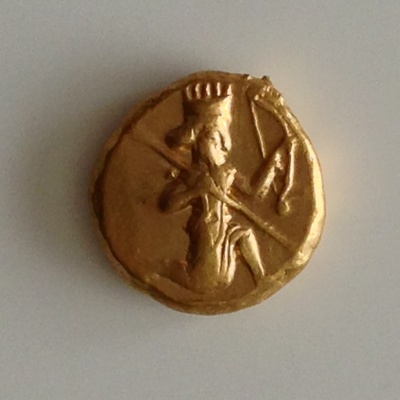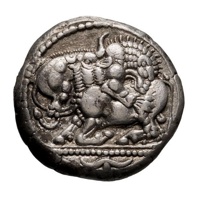
Ionian Electrum stater
Flying Bird Design
Samoan weight standard, 17.32 g
mid 7th century B.C.E.
Stack's NYICS auction Jan 5, 2012, lot# 267
(photo by Stack's)
One of the World's First Coins. Catalogued by Stack's as "excessively rare", with fewer than 10 known specimens. "While Lydia is often credited with the invention of coinage, in numismatics the earliest Electrum coins are usually attributed to Ionia." Electrum and the Invention of Coinage, 2011, Joseph Linzalone, p9.
Samos, where this coin was made is part of the Ionian Greek civilization, and is an island just off the coast of Ionia.
Electrum is described as a "naturally occurring alloy of gold & silver traceable to certain deposits found near the Western coast of the Mediterranean.
The Samoan electrum coins have been found in several hoards. One hoard was found in the 1880's and included one full stater. Another hoard dates from the 1960's and only has fractional pieces.
The Electrum Coinage of Samos in the Light of a Recent Hoard
Dr. Rudolf Habelt, Bonn, Germany, exact pub date unknown but after 2004.

Aegina, silver didrachma also called a stater
480 - 457 B.C.
(StacksBowers NYINCS 8 Jan 2016, #30074)
(The Syracuse Collection, Part III. Ex: Coin Galleries November 2002, Lot# 122)
Turtle stater
Aegina, silver didrachma 12.30 gms,Milbank-pl. I#13; SNG Cop-507
smooth shelled turtle or rather T-shaped pattern pellets on back.

Darius I (r. 522 - 486 BC)
Persian gold daric
Gorney & Mosche
1992, lot# ___
Acheamid Persia, gold daric

Macedon, City State of Akanthos
tetradrachm
---

Lydia
foree of a croeseid
(510-480 BC)
fouree
CNG
22 May, 2014, lot# 111
These coins are attributed to the Greek independent kingdom of Lydia where they are arguably the 1st silver coinage. They are commonly referred to as Croisads or a Double Siglos. After Persia conquered Lydid, the Persians kept using the Lydian design for a while before making their own coinage types.
Foree is a contemporary plated copy of a coin. Usually gold of silver but filled with copper inside.
For some reason these have spiked upwards in price, forcing me to buy a foree rather than a pure specimen. Fortunately prices have come down again. There is quite some variation in the design relating to the exact time when they were made.